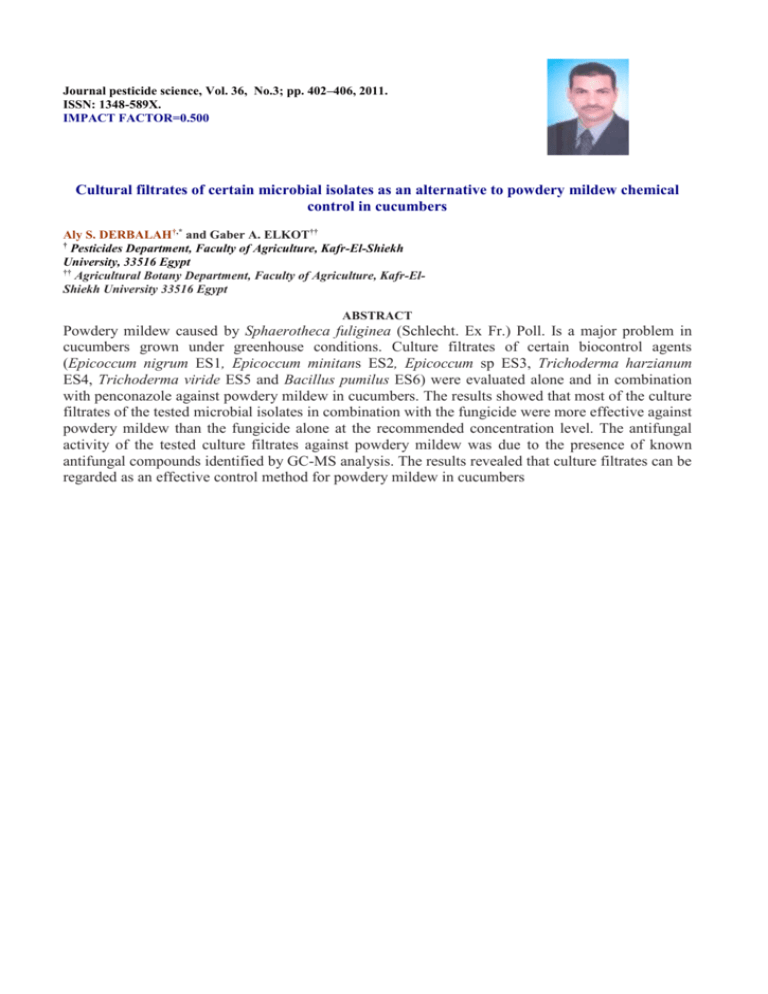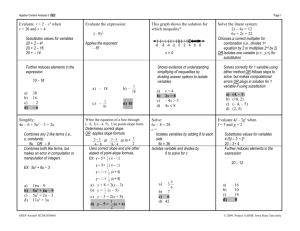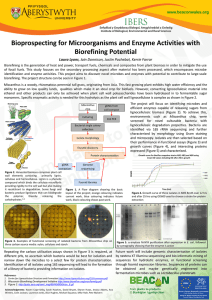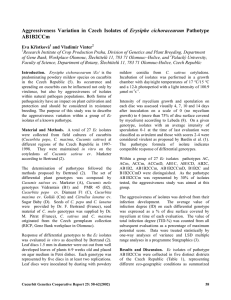
Journal pesticide science, Vol. 36, No.3; pp. 402–406, 2011.
ISSN: 1348-589X.
IMPACT FACTOR=0.500
Cultural filtrates of certain microbial isolates as an alternative to powdery mildew chemical
control in cucumbers
Aly S. DERBALAH†,* and Gaber A. ELKOT††
†
Pesticides Department, Faculty of Agriculture, Kafr-El-Shiekh
University, 33516 Egypt
††
Agricultural Botany Department, Faculty of Agriculture, Kafr-ElShiekh University 33516 Egypt
ABSTRACT
Powdery mildew caused by Sphaerotheca fuliginea (Schlecht. Ex Fr.) Poll. Is a major problem in
cucumbers grown under greenhouse conditions. Culture filtrates of certain biocontrol agents
(Epicoccum nigrum ES1, Epicoccum minitans ES2, Epicoccum sp ES3, Trichoderma harzianum
ES4, Trichoderma viride ES5 and Bacillus pumilus ES6) were evaluated alone and in combination
with penconazole against powdery mildew in cucumbers. The results showed that most of the culture
filtrates of the tested microbial isolates in combination with the fungicide were more effective against
powdery mildew than the fungicide alone at the recommended concentration level. The antifungal
activity of the tested culture filtrates against powdery mildew was due to the presence of known
antifungal compounds identified by GC-MS analysis. The results revealed that culture filtrates can be
regarded as an effective control method for powdery mildew in cucumbers
hemosphere (2008) 71 :2173–2179
Fate of imidacloprid in soil and plant after application
to cotton seeds
Sherif E. El-Hamady a, R. Kubiak b, Aly S. Derbalah a,*
a Pesticides Department, Faculty of Agriculture, Kafr El-Sheikh University, 33516
Kafr-El- Sheikh, Egypt b Ecology Department, SLFA, Neustadt/W
Abstract
This study aimed to investigate the persistence of imidacloprid in soil after
application to cotton seeds and to obtain a complete picture on the mass balance
of this compound in soil and cotton plants. The study was carried out as a pot
culture experiment under laboratory conditions using a Gaucho formulation
containing 14C-labeled imidacloprid. Three treatments of cotton seeds were
made in sandy loamy soil: live seeds grown in autoclaved soil, dead seeds put in
live soil and live seeds grown in live soil. Results showed that total 14C
recoveries decreased by time ranging 93.8–96.2, 77.1–88.4 and 53.5–62.4% of
the applied radioactivity at 7, 14, and 21 d after application, respectively. The
reduction in the extracted 14C from soil coincided with the increase of nonextracted ones. Levels of bound 14C was always less in autoclaved soil than in
live ones. Results revealed also that only 1.8–6.8% of the applied 14C was taken
up by the plants and fluctuated within the test period. 14C levels were higher in
plants grown in autoclaved soil than those in live ones and the radioactivity
tended to accumulate on the edges of cotton leaves. Most of the radioactivity in
the soil extracts was identified as unchanged 14C-imidacloprid. _ 2007 Elsevier
Ltd. All rights reserved.
Journal of Environmental Sciences (2008) 20 :262–267
Microbial detoxification of metalaxyl in aquatic system
Ahmed H. Massoud1, Aly S. Derbalah1,*, El-Sayed. B. Belal2
1. Pesticides Department, Faculty of Agriculture, Kafr El-Sheikh University. Kafr ElSheikh 33516, Egypt.
E-mail: masoudahm@yahoo.com
2. Agriculture Microbiology, Agriculture Botany Department, Faculty of Agriculture, Kafr
El- Sheikh University, Kafr El-Sheikh 33516, Egypt
Abstract
Four microorganisms, Pseudomonas sp. (ER2), Aspergillus niger (ER6),
Cladosporium herbarum (ER4) and Penicilluim sp. (ER3), were isolated from
cucumber leaves previously treated with metalaxyl using enrichment technique.
These isolates were evaluated for detoxification of metalaxyl at the
recommended dose level in aquatic system. The effect of pH and temperature on
the growth ability of the tested isolates was also investigated by measuring the
intracellular protein and mycelia dry weight for bacterial and fungal
isolates,respectively. Moreover, the toxicity of metalaxyl after 28 d of treatment
with the tested isolates was evaluated to confirm the complete
removal of any toxic materials (metalaxyl and its metabolites). The results
showed that the optimum degree pH for the growth of metalaxyl degrading
isolates (bacterial and fungal isolates) was 7. The temperature 30°C appeared
to be the optimum degree for the growth of either fungal or bacterial isolates. The
results showed that Pseudomonas sp. (ER2) was the most effective isolate in
metalaxyl degradation followed by Aspergillus niger (ER6), Cladosporium
herbarum (ER4) and Penicilluim sp. (ER3), respectively. There is no toxicity of
metalaxyl detected in the supernatant after 28 d of treatment with Pseudomonas
sp. (ER2). The results suggest that bioremediation by Pseudomonas sp. (ER2)
isolate was considered to be effective method for detoxification of metalaxyl in
aqueous media.
Land Contamination & Reclamation,(2008) 16 (1) :13-23
Biodegradability of famoxadone by various
microbial isolates in aquatic systems
A.S.H. Derbalah, E.B. Belal and A.H. Massoud
Department, Faculty of Agriculture, Kafr El-Sheikh Univ., Kafr El-Sheikh
33516, Egypt. Tel. 204-7325-5831, fax 204-7323-2032, email
aliderbalah@yahoo.com
Abstract
Bioremediation is defined as the process whereby organic
wastes are biologically degraded under controlled conditions to an
innocuous state, or to levels below concentration limits
established by regulatory authorities. In this study, four
microorganisms (Pseudomonas sp. (EB1), Aspergillus niger (EB2),
Cladosporium herbarum (EB4) and Penicillium sp. (EB3) were
isolated from cucumber leaves previously treated with
famoxadone, using an enrichment technique. These isolates were
evaluated for the detoxification of famoxadone at the concentration
level of 100 μg mL–1 in an aquatic system. The effects of pH and
temperature on the growth of the tested isolates were also
investigated by measuring the intracellular protein and mycelial
dry weight for bacterial and fungal isolates, respectively.
Moreover, the toxicity of famoxadone after 28 days of treatment with
the tested isolates was evaluated to confirm the removal of any toxic
materials (i.e. famoxadone and its metabolites). The results showed
that the optimum pH for the growth of famoxadone-degrading
isolates (i.e. bacterial and fungal isolates) was pH 7. A temperature
of 30°C appears to be optimal for the growth of either fungal or
bacterial isolates. Isolates of Pseudomonas sp. (EB1) and
Aspergillus niger (EB2), were the most effective isolates in
of isolates
by
followed famoxadone degradation,
and Penicillium sp. (EB3), (EB4) herbarum Cladosporium
respectively. A slight toxicity of famoxadone against A. solani
the in detected was
target sensitive a as
treated byPseudomonas sp. (EB1),
supernatant
Aspergillus niger (EB2) and Penicillium sp. (EB3) as compared
that
suggest results Thecontrol. the with
of famoxadone by Pseudomonas sp. (EB1), bioremediation
Aspergillus niger (EB2) and Penicillium sp. (EB3) is promising for
the detoxification of famoxadone in aqueous media. Moreover, the
tested microorganisms isolated from cucumber leaves may be
able to significantly reduce the residue level of famoxadone in
vegetable crops to below the maximum limit, especially under
greenhouse conditions.









